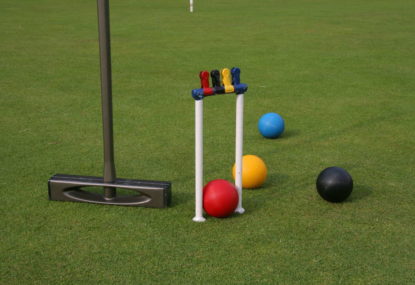JackJumpers' NBL title was special - but where does it sit among Tasmania’s top ten sporting moments?
It’s a pretty good time to be a Tasmanian sports fan right now. After years in the sporting wilderness with not much to celebrate,…

The crack on willow has its strong appeal. There is the sweet spot a foot finds propelling the ball to goal. The soft echo in a table tennis hit merits comparison with the ping off a golf tee.
My ears recall still the tennis ball, then white, on gut and when it struck an old net. But in croquet, there you have the thwack.
I am a novice of the game. Were I 170 years old, I would have picked up my first mallet in the 1850s, and have come of age in time to purchase the 1864 “Croquet: Laws and Regulations of the Game” by John Jacques II.
Even then, the thwack was already in New Zealand and Australia.
A watercolour thought to be from the 1840s shows a Bay of Islands house lawn set with croquet hoops, ready for a game. Papers Past has an editorial in The Taranaki Herald newspaper of January 24, 1863 referring to croquet as “that queen of games”.
“The lessons taught in the play ground are as important as some of those taught in the school room. The boy who has learnt to face quick bowling with the chance of getting his fingers smashed or his shins broken, has learnt a lesson as valuable as an extra rule of arithmetic or algebra, or a little more accurate knowledge of latin versification.”
Both the bails and the gloves came off against latin.
A croquet game in progress at Government House, Perth is shown in a photograph from about 1860. Trove has merchants selling croquet sets through The Hobart Mercury newspaper in September 1861 and through The Sydney Morning Herald in October 1861.
These could be bought in King Street, described as “The Game of Croquet, the best out-of-door game for ladies and gentlemen”. The same newspaper is advertising “Family Table Mangles” around the corner in York Street, so perhaps in those days it was better to be out of doors.
The game has evolved in the modern era. Suggestions on the websites of the World Croquet Federation and the Edinburgh Croquet Club that croquet’s early version encouraged gentlemen to render assistance to a lady who had pushed her ball in the rhododendron bushes are unknown to me. Our club has only azaleas.
The antipodean enthusiasm continues, with the first Trans Tasman Golf Croquet competition in Nelson, New Zealand in early December 2015. I understand the most recent Trans Tasman, in 2013, saw Australia beat New Zealand in Association Croquet.
The thwack is modified now through wood, carbon fibre and more, with hardened milled plastic balls and brushed metal hoops. There is another sound, when mallet head meets ankle bone. Yet neither this nor any jubilant thwack will generally result in vulgar exclamation.
As brutal as the tactics may be, croquet rarely fosters abuse. The occasional ‘good shot’ is not unwelcome and some of the shots are good; some are great. Yet some excel: a resting ball thwacked downwards will jump from pliant grass over another ball and through the hoop. At speed. And often towards the next hoop.
The waves instantly need be Mexican. When the first ball pirouettes on top of the second before passing through the hoop, medals need be struck.
I’d like to have an iconic Australian film showing croquet. In the past, folks from Melbourne seem to lead the way with sporting endeavours in the cinema. There is bowls and “Crackerjack”, others travelled up to Parkes to play cricket in “The Dish” and there was fly fishing and motor racing in “On the Beach”.
The legal battles in “The Castle” as readily might be played out using a football or netball, the High Court umpires and referees finally seeing the game to right as they blew full-time.
I’d cast Chips Rafferty, in a croquet pair with Deborah Mailman. They’d meet Bill Hunter and Mia Wasikowska in the final. Clifton Pugh’s wombat would emerge beneath the wintergreen couch like an exocet tree root, but Chips still takes the winning shot. The hoops and peg packed away, there are pies and pav in the clubhouse. Credits roll.
Contrary to some expectations, neither the game nor its players are of the past. Both New Zealand and Australia have world-class champions aged in their 20s. The modern is known to us.
I see metadata as a metaphor. Stevensons’ lighthouses will not move even when security agencies shift the GPS grid. One hundred and forty characters are not enough. And a good thwack can still be heard when playng croquet, even when players turn 170.